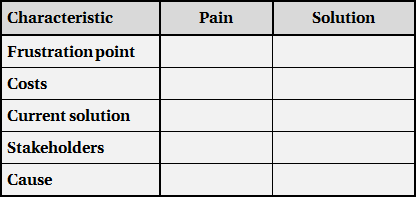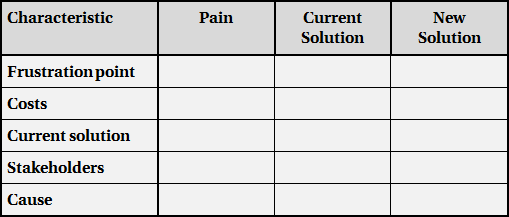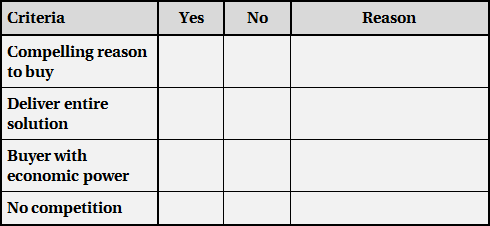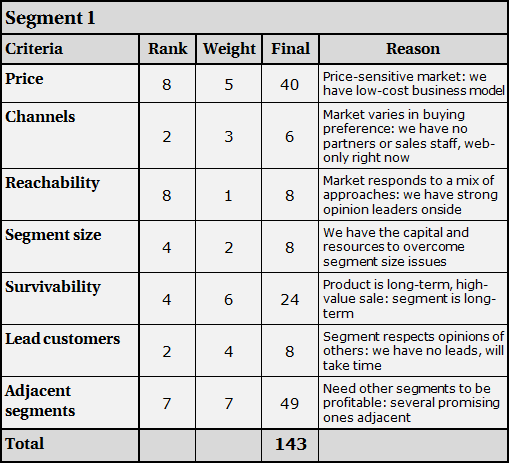This article explores the importance of good segmenting and targeting to early-stage companies. Most software companies fail within the first three years, and one of the prime reasons is a lack of a focused approach to a single, carefully-chosen target market. Most software companies take the approach of attacking multiple segments simultaneously to see which will work out best, but run out of time and money before they reach an answer. A concentrated strategy that focuses resources on a single segment that the company can win and dominate quickly significantly reduces go-to-market risk. Choosing a segment in the right direction is more important than choosing the right segment.
This article provides a series of six steps to help companies work through a segmenting and targeting exercise that will give them the best chance of success. The article provides real-world tools to help deal with an essential issue.
Background
This article is based on marketing lectures given by the author to entrepreneurs in the Lead to Win program. Lead to Win is a vendor-neutral business ecosystem designed to grow creative companies for the purpose of generating technology and knowledge jobs in Canada’s Capital Region. When the first Lead to Win program ran over eight years ago, the majority of software entrepreneurs in the room were pursuing enterprise, proprietary business models. At the time, open source was thought of as “freeware” and very few were aware of its future significance. Since then, things have changed. Among the software entrepreneurs in Lead to Win, open source software startups now find themselves in the majority.
As business models have changed, much of the content in the Lead to Win program has changed accordingly. It is interesting to see what content areas have not changed, particularly the section on segmenting and choosing target markets. The reason may be that some things don’t, or rather can’t, change. There are fundamental truths about running a young company that function like the Laws of Physics:
- Over the long term, a growing company cannot spend more money than it brings in.
- A young company cannot build profit and win significant market share at the same time as these are mutually exclusive.
- There is always competition.
- The greatest competitor is apathy.
- Any company should know its customers better than anyone else.
- A young company that focuses on a single target market has a far greater chance of success.
The Importance of Market Segmentation
Segmenting and targeting together comprise the task of examining a product’s entire potential addressable market, segmenting that market into sub-segments according to various criteria and then choosing a single segment as the go-to-market target. A simple and common example is soap. The entire addressable market for soap is all persons in the world who wash themselves. From there, broad sub-segments may divide that huge market up by continent, then by gender, and then by age until there are several dozen large sub-segments. From there, segments can be further refined until certain underserved and undominated ones emerge, such as organic soap for babies or soap for very old and delicate skin. From there, the new soapmaker looking to focus on a promising single market may choose the latter as the target, concentrating product development, distribution, marketing, promotion, and pricing to become the dominant brand in that one particular sub-segment. Moreover, it is important that the soapmaker be able to build critical mass in the segment quickly, preferably dominating it.
Between 80 and 90% of software startups fail within the first three years, depending on how failure is defined. While they mostly run out of money, the root of the problem is often poor marketing, specifically poor segmenting and targeting. Most people think of marketing as promotion through events, advertising, social media, direct email, or viral methods. But those activities, correctly and collectively known as marketing communications, are the very last marketing activities that should be done. Marketing is better described as bringing the right product to the right market at the right price at the right place. If this function is executed poorly, nothing else matters and nothing else can be done to fix the problem. No amount of promotion or creative sales technique will save a company that practices poor segmenting and targeting.
A common mistake, made by open source and proprietary software companies alike, is to create something and then look for a market that will buy it. The company that designs a product and then enters the market looking for a customer will struggle. The company that first asks potential customers about their most pressing problems and then designs a compelling product to solve one of these problems is far more likely to succeed, even more so if the problem is a priority to the customer. Unfortunately, software companies tend to have a technology bias rather than a market bias.
Why do so many software companies get this wrong? And more importantly, what can they do to get it right, or at least as right as possible? There are a number of reasons why poor marketing is prevalent, including technology arrogance, lack of market information, indecision, and ignorance of segmenting and targeting. The latter is particularly common, and in open source and other software communities, it generally takes the form of creating differently-priced product feature sets, licensing, and support packages for different target segments. That kind of segmenting only starts to be successful after a company becomes well established and has enough customers that meeting their differing needs becomes a priority. A new open source company trying to go to market for the first time should instead focus on developing a clear idea of who they are selling to, what their customers’ problems are and why the customers would use this product over any other. Pricing models should clearly serve the needs and preferences of that single target.
Ideally, a company should identify their target market and the value they bring to it before their product even enters the design stage. But that rarely happens. At a minimum, they should have a market in mind before they take the product to market. It is less important that the target market is the absolute right one than it is to have a target market that is more or less in the right direction. If there is no target to aim for, there is no way to measure progress or success. If there is no target market, it is impossible to build critical mass or penetration. And, trying to sell into multiple segments to see which one works the best usually fails as the company will run out of time and money before finding the answer.
Segmenting and Targeting Exercise
How does a company decide which market segment to target first? There are a number of steps that an entrepreneur can take to help establish an initial target market. The remainder of this article describes a practical exercise of six steps to help identify a company’s initial target market.
1. Define the total addressable market and all possible sub-segments: the first step in determining the target market is to create as broad a definition of an addressable market as possible, and then break it down into all possible sub-segments. This should be done in a group setting that includes colleagues and knowledgeable friends who are willing to contribute ideas creatively. The goal is to reach a generic definition of what the product could be used for, and then write down as many broad applications and uses for the product as possible. The challenge to the participants is to think in terms of how people, rather than organizations or other entities, could use the product. The best results are achieved when the participants are encouraged to be open-minded and imaginative, and contribute any and all ideas.
The number and range of ideas that will be generated will depend on the group and on the product itself. Some software products will have many different applications and uses, while others are more limited in how and where they can be used. If a sufficient number of ideas is generated, it may be possible to sort them into groups based on common characteristics, such as “industry type” or “problem that is addressed”.
2. Create customer profiles: a constant problem that software companies face, especially those in the business-to-business market, is obtaining market data. It is difficult to know much about the target segments, such as what their problems are, what benefits they really want, what their priorities are, their ability to pay, and how many of them are out there. A company must turn to informed intuition, rather than analytical reasoning, in order to paint a picture of their customer.
This second step presumes that the company has some experience with the broad addressable market. Most entrepreneurs have worked in a related domain or have experience with related software, making it unusual for someone to start a company cold. Past experience is the start of intuition. From that basis, the company will sketch a brief single-page profile of a typical customer in the market segments previously identified in the first step.
The approach should be wide and ranging, building upon the team’s own experience, readings, and colleagues as sources. Additional sources may include experience from unsuccessful deals, past customers, related software product categories, and any current customers. Team members should resist the urge to rely only on web-based information sources. The telephone remains one of the most effective information-gathering tools and companies should not hesitate to use it.
Each profile should consider the customer from both the organizational and individual-buyer perspective–unless the opportunity is targeted at consumers, in which case only the individual is relevant. The profile need not be lengthy but should answer the following questions:
- What problem causes the pain or frustration, or gets in the way of the benefit?
- How does the customer try to cope with the problem now?
- Is the problem on the customer’s priority list for this year?
- What is causing the problem? What is interfering with a speedy solution? What goes wrong and why?
- How much money is the customer losing, either in additional costs or lost revenue? Can the pain be quantified?
- Who is the individual who feels the pain first and how does it propagate upward or downward within the customer’s organization?
- Who else feels the pain? The customer’s customers? Suppliers? Partners? Investors?
- What is the buyer’s personal motivation and at what level are they in the organization?
- What is the buyer’s demographic profile?
A simple chart, seen in Figure 1, can help focus and organize this part of the exercise. The middle column quantifies, or at least describes what is happening for each characteristic. The right column describes how the customer is dealing with the issue now. A pain or frustration point in this context can include quality of life, inconvenience, lost opportunities, and other aspects that are not problems per se. The characteristics should suit the segments under consideration.
Figure 1. Customer Profile Chart

3. Assess how well the product fits the customer’s need: the next step is to determine how well the solution addresses the customer’s problem. This involves a critical evaluation of whether the product: i) matches the customer’s pain point; ii) is a compelling improvement over the current solution; or iii) will introduce new problems. A slightly modified version of the previous chart, seen in Figure 2, helps describe the company’s solution relative to what the customer is currently doing. As much as possible, this should be an honest and objective assessment.
Figure 2. Product-Customer Fit Assessment Chart

Once this assessment has been completed, the result should be a short stack of one-page profiles. To complete this step, the profiles should be sorted into categories with common characteristics such as industry, type of buyer, pain point, and current solution.
4. Create a short-list of promising segments: at this point in the process, there may be many appealing candidates among the profiles. It would be unwise, however, for a company to attempt to target all of these segments. A focused approach makes better use of limited resources, is more resistant to competitive pressure, produces a better product, and builds community.
Now begins the process of filtering the stack until eventually one segment remains. Each profile will be assessed against critical-flaw criteria that can “make or break” the chance of succeeding in that segment. This is done by asking a series of questions and rating the answers on a binary scale of yes or no, including brief details that justify the rating and eliminating any profile that fails.
The first question is: of all the possible ways of solving the problem, is the proposed solution the obvious choice from the point of view of each of the following?
- total cost, including installation, services, training, and adoption costs
- risk of new problems
- speed to implement
- ease of use and adoption
- maintenance and support
- stability of technology and company
It is difficult to rate the solution honestly. Of course a company loves its product, but will its customers? It is important to remember that both companies and individuals have a laundry list of problems and wishes and limited time and money. Most companies and individuals will only spend money and time on those problems that are a top priority. As a CIO once told the author years ago, “I have 958 problems, but I only have the capacity to solve the top 30 in the next two years”. This suggests that the success of a solution depends on it addressing something in that all-important “top 30”.
Next, answer as honestly as possible the next series of questions:
- Can the company supply the entire solution or does it depend on others for certain elements such as training, specific skills, hardware or applications? Is this a barrier? Are the missing components of the offering readily available? If the proposed solution is part of a bigger offering, does that offering satisfy the requirements?
- Does the customer have the ability to pay? Do they have budget? Do the individuals have the authority? How do they prefer to buy and can it be delivered by the company in an appropriate way?
- Is there entrenched competition that the customer already prefers to buy from or that will be a formidable foe? A new entrant should not attempt to fight toe-to-toe with entrenched offerings, particularly if the incumbent has brand strength. Is there a great deal of dissatisfaction with the competition? How quickly can the competition correct the cause?
The chart seen in Figure 3 can help when assessing a product against critical-flaw criteria. Following this assessment, the stack should be reduced to about four or five target candidate profiles.
Figure 3. Critical-Flaw Criteria Chart

5. Select a target segment: in this step, the remaining profiles are continuously assessed against seven selection variables that determine the solution’s market viability until the top segment remains.
Variable 1: at what price will the customer buy? At what price can the company sell and stay in business? Total cost to the customer should be considered here, including training, support or maintenance, transition expenses, and expected costs of installing and testing updates. This assessment should also consider the software company’s investment in development, ongoing costs, any margins that may be required and whether the priority is to be profitable or to quickly obtain market share without going under.
Variable 2: does the company have the right sales channel to reach that segment? New software enterprises often overlook this aspect or simply assume that sales will be driven by their website or salespeople. If the software is truly simple to install, requires no training and performs a minor function in the general scheme of things and therefore presents little risk, then web-based sales may be sufficient. If the product is open source and the customers are open source developers, web-based sales may be sufficient. But organizations and people prefer to buy major products from known and trusted brands and are loathe to buy from a small company they have never heard of or directly from the web without ever speaking to anyone from the company. The right sales channel is critical to bringing the product into the market successfully.
Variable 3: is the segment reachable? There is little point in targeting a segment that the company cannot communicate with. What type of media do they consume? Is it social media? Does the company have resources to market the product adequately? Does the company know and understand the segment sufficiently to be credible?
Variable 4: is the segment small enough for the product to gain critical mass and dominate? This seems counter-intuitive, but large segments are usually heavy with competition, are hard to capture any significant share in, and cost more money to penetrate. The segment should be small enough to dominate, but large enough to meet the company’s needs within the first two years. If capturing 50% of the buyers in the segment does not allow the company to break even at that point, then it is likely not a viable segment to target.
Variable 5: will the segment survive? Is the segment at risk for its own survival because of competitive saturation, financial instability or a technology shift? Can the remaining lifespan of the segment be estimated?
Variable 6: can the company approach and win lead customers in that segment? This requires connections, the right calling cards, the right offering, and the right marketing. The segment has to have a history of adopting and actually deploying new solutions throughout the organization. Are there some in the segment who feel the pain more acutely? Do the potential lead customers have credibility with others in the segment? Will they participate in the design, development, and test processes? Will they pay? The product shouldn’t be given away just to win a lead customer. A lead customer who does not pay is not a customer.
Variable 7: does the segment open doors to other, related segments? A viable long-term business cannot be built on one small segment that can be dominated. It requires branching out to other related segments. A company should ensure adjacent segments are available, not already dominated by a competitor and will lead to profitability over time.
These seven selection variables are assigned weightings and rankings to determine which segment will come out on top. An example of a chart to help with this assessment is shown in Figure 4. Priorities are based on weighting where “1” is least important and “7” is most important. The solutions are ranked on a quality scale where “1” is poor and “10” is excellent. After the weightings and rankings are multiplied, the segment with the highest score moves on to the final round. The figure below provides a basic example, but weightings may change depending on the characteristics of the segment. For example, one segment may be more price-sensitive than another, requiring a shift in weighting. Rank indicates the company’s strength in meeting the segment requirement. These variables are provided as a starting point, but depending on the context, segments may require assessment against other variables.
Figure 4. Selection Variable Assessment Chart Example

6. Test the target segment: the previous five steps have narrowed the segments down to one target segment with the second-highest-ranking segment as a standby. The final step is to test the target segment using a SWOT analysis against overall performance goals. If applicable, investors input is recommended.
The results of this exercise depend upon an honest and faithful approach at each of the six steps. If the final target segment does not “feel right,” the standby can be considered. Alternatively, the process can be repeated with a view to reducing bias, including invitations to neutral business colleagues to participate.
Conclusion
In going to market, a strong focus on a single segment that can be dominated quickly is imperative to success. Pursuing a number of segments simultaneously to see which one “sticks” risks disaster. Following the steps described in this article can help a company identify a market segment to target. While it is not essential to choose the perfect target market from the start — although to do so would have notable advantages — it is essential to have a well-defined target in mind and make course adjustments along the way. This approach increases the chances of having a more successful journey and reaching a more profitable destination.